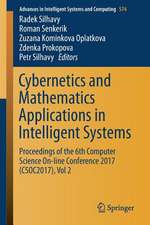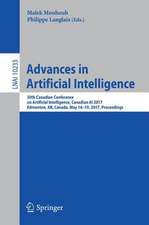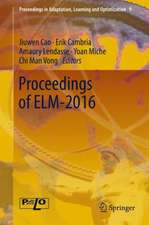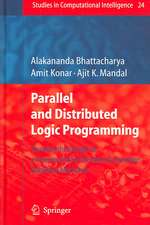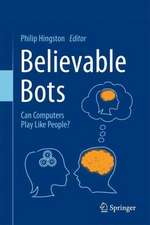Time-Series Prediction and Applications: A Machine Intelligence Approach: Intelligent Systems Reference Library, cartea 127
Autor Amit Konar, Diptendu Bhattacharyaen Limba Engleză Hardback – 3 apr 2017
Primarily written for graduate students and researchers in computer science, the book is equally useful for researchers/professionals in business intelligence and stock index prediction. A background of undergraduate level mathematics is presumed, although not mandatory, for most of the sections. Exercises with tips are provided at the end of each chapter to the readers’ ability and understanding of the topics covered.
| Toate formatele și edițiile | Preț | Express |
|---|---|---|
| Paperback (1) | 1042.28 lei 6-8 săpt. | |
| Springer International Publishing – 21 iul 2018 | 1042.28 lei 6-8 săpt. | |
| Hardback (1) | 1048.53 lei 6-8 săpt. | |
| Springer International Publishing – 3 apr 2017 | 1048.53 lei 6-8 săpt. |
Din seria Intelligent Systems Reference Library
- 20%
 Preț: 1050.59 lei
Preț: 1050.59 lei - 20%
 Preț: 1157.60 lei
Preț: 1157.60 lei - 20%
 Preț: 648.44 lei
Preț: 648.44 lei - 20%
 Preț: 650.08 lei
Preț: 650.08 lei - 20%
 Preț: 1005.64 lei
Preț: 1005.64 lei - 5%
 Preț: 968.90 lei
Preț: 968.90 lei - 20%
 Preț: 1052.67 lei
Preț: 1052.67 lei - 20%
 Preț: 1171.46 lei
Preț: 1171.46 lei - 20%
 Preț: 1164.84 lei
Preț: 1164.84 lei - 20%
 Preț: 815.84 lei
Preț: 815.84 lei - 20%
 Preț: 989.96 lei
Preț: 989.96 lei - 20%
 Preț: 1063.41 lei
Preț: 1063.41 lei - 20%
 Preț: 925.45 lei
Preț: 925.45 lei - 20%
 Preț: 504.38 lei
Preț: 504.38 lei - 18%
 Preț: 1113.26 lei
Preț: 1113.26 lei - 20%
 Preț: 1920.04 lei
Preț: 1920.04 lei - 20%
 Preț: 990.62 lei
Preț: 990.62 lei - 20%
 Preț: 651.57 lei
Preț: 651.57 lei - 20%
 Preț: 645.97 lei
Preț: 645.97 lei - 20%
 Preț: 660.16 lei
Preț: 660.16 lei - 20%
 Preț: 647.13 lei
Preț: 647.13 lei - 20%
 Preț: 654.05 lei
Preț: 654.05 lei - 20%
 Preț: 649.93 lei
Preț: 649.93 lei - 20%
 Preț: 648.11 lei
Preț: 648.11 lei - 20%
 Preț: 657.99 lei
Preț: 657.99 lei - 20%
 Preț: 656.84 lei
Preț: 656.84 lei - 20%
 Preț: 1624.04 lei
Preț: 1624.04 lei - 20%
 Preț: 642.98 lei
Preț: 642.98 lei - 20%
 Preț: 649.60 lei
Preț: 649.60 lei - 20%
 Preț: 651.23 lei
Preț: 651.23 lei - 20%
 Preț: 653.06 lei
Preț: 653.06 lei - 20%
 Preț: 1002.99 lei
Preț: 1002.99 lei - 20%
 Preț: 645.14 lei
Preț: 645.14 lei - 20%
 Preț: 658.33 lei
Preț: 658.33 lei - 20%
 Preț: 644.98 lei
Preț: 644.98 lei - 20%
 Preț: 646.62 lei
Preț: 646.62 lei
Preț: 1048.53 lei
Preț vechi: 1310.66 lei
-20% Nou
Puncte Express: 1573
Preț estimativ în valută:
200.64€ • 214.55$ • 167.29£
200.64€ • 214.55$ • 167.29£
Carte tipărită la comandă
Livrare economică 17 aprilie-01 mai
Preluare comenzi: 021 569.72.76
Specificații
ISBN-13: 9783319545967
ISBN-10: 3319545965
Pagini: 242
Ilustrații: XVIII, 242 p. 69 illus., 13 illus. in color.
Dimensiuni: 155 x 235 x 16 mm
Greutate: 0.54 kg
Ediția:1st ed. 2017
Editura: Springer International Publishing
Colecția Springer
Seria Intelligent Systems Reference Library
Locul publicării:Cham, Switzerland
ISBN-10: 3319545965
Pagini: 242
Ilustrații: XVIII, 242 p. 69 illus., 13 illus. in color.
Dimensiuni: 155 x 235 x 16 mm
Greutate: 0.54 kg
Ediția:1st ed. 2017
Editura: Springer International Publishing
Colecția Springer
Seria Intelligent Systems Reference Library
Locul publicării:Cham, Switzerland
Cuprins
An Introduction to Time-Series Prediction.- Prediction Using Self-Adaptive Interval Type-2 Fuzzy Sets.- Handling Multiple Factors in the Antecedent of Type-2 Fuzzy Rules.- Learning Structures in an Economic Time-Series for Forecasting Applications.- Grouping of First-Order Transition Rules for Time-Series Prediction by Fuzzy-induced Neural Regression.- Conclusions and Future Directions.
Textul de pe ultima copertă
This book presents machine learning and type-2 fuzzy sets for the prediction of time-series with a particular focus on business forecasting applications. It also proposes new uncertainty management techniques in an economic time-series using type-2 fuzzy sets for prediction of the time-series at a given time point from its preceding value in fluctuating business environments. It employs machine learning to determine repetitively occurring similar structural patterns in the time-series and uses stochastic automaton to predict the most probabilistic structure at a given partition of the time-series. Such predictions help in determining probabilistic moves in a stock index time-series
Primarily written for graduate students and researchers in computer science, the book is equally useful for researchers/professionals in business intelligence and stock index prediction. A background of undergraduate level mathematics is presumed, although not mandatory, for most of the sections. Exercises with tips are provided at the end of each chapter to the readers’ ability and understanding of the topics covered.
Primarily written for graduate students and researchers in computer science, the book is equally useful for researchers/professionals in business intelligence and stock index prediction. A background of undergraduate level mathematics is presumed, although not mandatory, for most of the sections. Exercises with tips are provided at the end of each chapter to the readers’ ability and understanding of the topics covered.
Caracteristici
Proposes generic solutions to the prediction of an economic time-series with alternative formulations using machine learning and type-2 fuzzy sets Offers original content and a unique presentation style Includes the source codes of the programs developed in MATLAB to accompany the book Requires a only a high-school understanding of algebra and calculus, and first-year-undergraduate-level programming skills Includes supplementary material: sn.pub/extras











